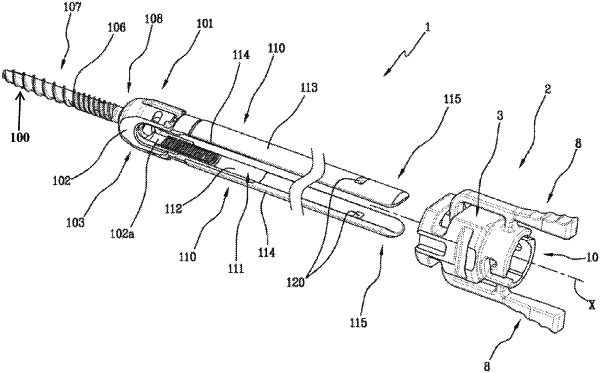| CPC A61B 17/7085 (2013.01) [A61B 90/03 (2016.02); A61B 2090/037 (2016.02)] | 8 Claims |

|
1. A surgical device comprising:
a polyaxial surgical screw comprising:
an internally hollow tulip having a first open end for accessing an interior of the tulip, a second end opposite to the first end, and a side wall developing between the first and second end, wherein said tulip comprises two elongated rods which are parallel and mutually spaced apart, each elongated rod protruding from the side wall and extending away from the first end of the tulip in a direction opposite to the second end of the tulip, said rods defining a channel in communication with the first end for accessing the interior of the tulip; and
a threaded shaft having a first end defining a screw tip and a second end opposite to the first end having a ball joint associated with the second end of the tulip to orient said shaft with respect to the tulip itself,
wherein the surgical device further comprises a locking unit which can be reversibly mounted on said polyaxial surgical screw, wherein said locking unit comprises a tubular body which has an inner cavity and is adapted to extend around said two elongated rods during a configuration of use of the surgical device, said tubular body having two mutually opposite protrusions which project into said inner cavity,
said protrusions being configured to face the channel defined between said rods and be interposed between said elongated rods to prevent mutual removal and approach of said elongated rods during the configuration of use of the surgical device;
wherein said rods have respective through holes at respective terminal ends of said rods, and wherein said locking unit comprises a pair of locking pins connected to said tubular body which can be switched during the configuration of use between a locking position, in which they are inserted into said through holes preventing axial sliding of the tubular body with respect to the rods, and a releasing position in which they are disconnected from the through holes;
wherein said locking unit comprises a pair of arms connected to said tubular body, each arm having a first end on which a respective locking pin is made and a second end disposed radially outwardly from the tubular body, the second end defining a gripping portion of the locking unit, the gripping portion comprising a plurality of indentations formed on an outer surface of the gripping portion, said arms being operable in rotation about respective fulcrums of the tubular body to approach the gripping portions and to move the locking pins respectively between the locking position and the releasing position and vice versa to switch the locking pins.
|